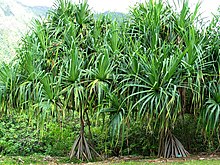Pandanaceae
| Pandanaceae | |
|---|---|
 | |
Pandanus tectorius | |
Scientific classification | |
| Kingdom: | Plantae |
Clade: | Angiosperms |
Clade: | Monocots |
| Order: | Pandanales |
| Family: | Pandanaceae R.Br.[1] |
| Genera | |
Benstonea Callm. & Buerki | |
Pandanaceae is a family of flowering plants native to the tropics and subtropics of the Old World, from West Africa through the Pacific. It contains 982 known species[2] in five genera,[3] of which the type genus, Pandanus, is the most important, with species like Pandanus amaryllifolius and karuka (Pandanus julianettii) being important sources of food. It is an ancient family dating from the early to mid-Cretaceous.[4]
Characteristics
Pandanaceae includes trees, shrubs, lianas, vines, epiphytes, and perennial herbs.[5]Stems may be simple or bifurcately branched, and may have aerial prop roots. The stems bear prominent leaf scars. The leaves are very long and narrow, sheathing, simple, undivided, with parallel veins; the leaf margins and abaxial midribs are often prickly.[6]
The plants are dioecious. The inflorescences are terminally borne racemes, spikes or umbels, with subtended spathes, which may be brightly colored. The flowers are minute and lack perianths. Male flowers contain numerous stamens with free or fused filaments. Female flowers have a superior ovary, usually of many carpels in a ring, but may be reduced to a row of carpels or a single carpel. Fruits are berries or drupes,[5] usually multiple.[7]
Genera
Pandanaceae includes five genera: Benstonea, Freycinetia, Martellidendron, Pandanus, and Sararanga.[3]Benstonea (as subgenus "Acrostigma")[8] and Martellidendron[4] were formerly considered subgenera of Pandanus, but were recognized as distinct genera based on DNA sequencing.[4][8]
| Wikimedia Commons has media related to Pandanaceae. |
References
^ Angiosperm Phylogeny Group (2009). "An update of the Angiosperm Phylogeny Group classification for the orders and families of flowering plants: APG III". Botanical Journal of the Linnean Society. 161 (2): 105–121. doi:10.1111/j.1095-8339.2009.00996.x. Archived from the original (PDF) on 2017-05-25. Retrieved 2013-06-26..mw-parser-output cite.citation{font-style:inherit}.mw-parser-output .citation q{quotes:"""""""'""'"}.mw-parser-output .citation .cs1-lock-free a{background:url("//upload.wikimedia.org/wikipedia/commons/thumb/6/65/Lock-green.svg/9px-Lock-green.svg.png")no-repeat;background-position:right .1em center}.mw-parser-output .citation .cs1-lock-limited a,.mw-parser-output .citation .cs1-lock-registration a{background:url("//upload.wikimedia.org/wikipedia/commons/thumb/d/d6/Lock-gray-alt-2.svg/9px-Lock-gray-alt-2.svg.png")no-repeat;background-position:right .1em center}.mw-parser-output .citation .cs1-lock-subscription a{background:url("//upload.wikimedia.org/wikipedia/commons/thumb/a/aa/Lock-red-alt-2.svg/9px-Lock-red-alt-2.svg.png")no-repeat;background-position:right .1em center}.mw-parser-output .cs1-subscription,.mw-parser-output .cs1-registration{color:#555}.mw-parser-output .cs1-subscription span,.mw-parser-output .cs1-registration span{border-bottom:1px dotted;cursor:help}.mw-parser-output .cs1-ws-icon a{background:url("//upload.wikimedia.org/wikipedia/commons/thumb/4/4c/Wikisource-logo.svg/12px-Wikisource-logo.svg.png")no-repeat;background-position:right .1em center}.mw-parser-output code.cs1-code{color:inherit;background:inherit;border:inherit;padding:inherit}.mw-parser-output .cs1-hidden-error{display:none;font-size:100%}.mw-parser-output .cs1-visible-error{font-size:100%}.mw-parser-output .cs1-maint{display:none;color:#33aa33;margin-left:0.3em}.mw-parser-output .cs1-subscription,.mw-parser-output .cs1-registration,.mw-parser-output .cs1-format{font-size:95%}.mw-parser-output .cs1-kern-left,.mw-parser-output .cs1-kern-wl-left{padding-left:0.2em}.mw-parser-output .cs1-kern-right,.mw-parser-output .cs1-kern-wl-right{padding-right:0.2em}
^ Christenhusz, M. J. M. & Byng, J. W. (2016). "The number of known plants species in the world and its annual increase". Phytotaxa. 261 (3): 201–217. doi:10.11646/phytotaxa.261.3.1.
^ ab taxonomy. "Taxonomy Browser". www.ncbi.nlm.nih.gov. Retrieved 29 October 2018.
^ abc ingentaconnect: Recognition of Martellidendron, a new genus of Pandanaceae, and its biogeographic implications
^ ab "Pandanaceae in Monocot Families (USDA) @ efloras.org". www.efloras.org. Retrieved 29 October 2018.
^ "Pandanaceae in Flora of China @ efloras.org". www.efloras.org. Retrieved 29 October 2018.
^ "Angiosperm families - Pandanaceae R. Br". delta-intkey.com. Retrieved 29 October 2018.
^ ab "Update on the systematics of Benstonea (Pandanaceae): When a visionary taxonomist foresees phylogenetic relationships" (PDF). (50 KB)